
Abdul Razak bin Dato' Haji Hussein was a Malaysian lawyer and politician who served as the second prime minister of Malaysia from 1970 until his death in 1976. He also served as the first deputy prime minister of Malaysia from 1957 to 1970. He is referred to as the Father of Development.
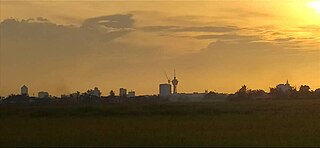
Alor Setar is the state capital of Kedah, Malaysia. It is the second-largest city in the state after Sungai Petani and one of the most-important cities on the west coast of Peninsular Malaysia. It is home to the third-tallest tower in Malaysia, the Alor Setar Tower.

The National Museum is a public museum in Kuala Lumpur, Malaysia dedicated to Malaysian art, culture, and history. Located on Jalan Damansara close to Perdana Lake Gardens across KL Sentral station. Its façade comprises elements from both traditional Malay and modern features. It was inaugurated on 31 August 1963, and it serves as a repository of Malaysia's cultural and historical heritage.

Malay houses refer to the vernacular dwellings of the Malays, an ethno-linguistic group inhabiting Sumatra, coastal Borneo and the Malay Peninsula.
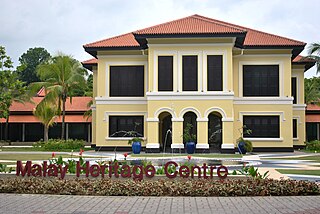
The Malay Heritage Centre is a cultural centre and museum located at Sultan Gate off Beach Road in Kampong Glam, Singapore. Its primary focus is to showcase the heritage and history of Malay Singaporeans.
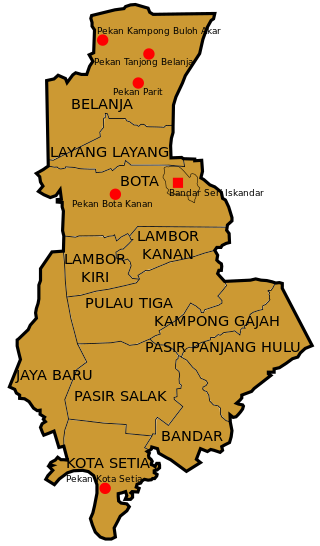
Bota is a mukim in Perak Tengah District, Perak, Malaysia. It comprises two geographical areas: Bota Kiri and Bota Kanan as it is divided by the Perak River. There is a river terrapin breeding center in Bota Kanan. Bota is also well known for its durian fruit. The town has over fifteen mosques.

Seni Gayung Fatani is a martial art, specifically a style of silat from Malaysia based on the art of war, the combination punch and kick striking, joint-locking and grappling techniques, and various type of melee weapon. In Malay, the word seni means art and gayung is a word for martial arts, synonymous with silat. Fatani means wise in Arabic and was chosen in 1976 by the councils of Guru Tua. The first grandmaster of the silat is Tuan Guru Hj Anuar Abd. Wahab (1976–2009). The second grandmaster was Tuan Guru Aminuddin Haji Anuar (2009–2023) and the current grandmaster of Seni Gayung Fatani Malaysia is Grandmaster Mohd Safwan Abu Hassan.
Tan Sri Zainal Abidin bin Ahmad or better known by the moniker Za'aba, was a Malaysian writer and linguist. He modernised the Malay language with the publication of a series of grammar books entitled Pelita Bahasa in 1936 at the Sultan Idris Training College. The book contained guidelines in modernising the structure of classical Malay, transforming it into the language that is in use today: the most significant change was the switch from the conventional passive to the modern active form of syntax.

The Malay Technology Museum is a museum in Kota Batu of Bandar Seri Begawan, Brunei. The museum's main objective is to present early Brunei's technical practices, which provide insight into the way of life of the country's inhabitants, who lived in both the water town and on dry ground.

The Chitty Museum is a museum about the minority Chitty community, which is located within the Chitty Village area in Malacca City, Malacca, Malaysia. It is housed in a traditional Chitty house which has been renovated by PERZIM.

The Figure Museum is a museum in Johor Bahru, Johor, Malaysia.
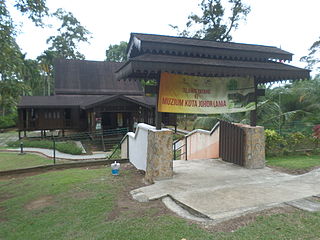
The Kota Johor Lama Museum is a museum in Johor Lama, Kota Tinggi District, Johor, Malaysia. The museum is about the history of Johor Lama.

Belait District Museum is a cultural and history museum located at Jalan Maulana, Kuala Belait, Belait District of Brunei.
Ismail Johari was the author of the Bukit Kepong novel published by Dewan Bahasa dan Pustaka (DBP) in 1990 and one of the main script writers of the Bukit Kepong film produced by Jins Shamsuddin in 1981, both of which were based on an actual armed incident that took place on 23 February 1950 between the Federation of Malaya Police and gunmen of the Malayan Communist Party during the Malayan Emergency. The Bukit Kepong novel was adopted as the Form 4 secondary school and Sijil Pelajaran Malaysia (SPM) educational teaching material.

Ahmad Samsuri bin Mokhtar, better known as Dr. Sam, is a Malaysian politician, aerospace engineer and lecturer who has served as the 15th Menteri Besar of Terengganu, Member of the Terengganu State Legislative Assembly (MLA) for Ru Rendang since May 2018 and the Member of Parliament (MP) for Kemaman since December 2023. He is a member of the Malaysian Islamic Party (PAS), a component party of the Perikatan Nasional (PN) coalition. He has also served as the Vice President of PAS since June 2019.
Yaakub Isa was a Malaysian teacher, writer, scholar of the Malay language and literature.
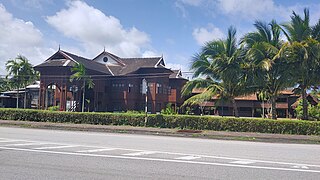
Rumah Warisan Haji Su is a complex of two traditional Malay houses located in mukim Losong, two kilometres from downtown Kuala Terengganu, Terengganu. The houses were owned by Haji Su Mohammed Salleh, which he inherited from his family. Haji Su was a shipping magnate in the pre-wars day and was record to have owned several ships or Perahu Besar plying the sea to Southern Thailand and a steam ship plying south to Singapore. After a renovation process by Lembaga Muzium Terengganu, the houses were reopened as heritage buildings and tourist attraction.

Husaini bin Omar is a Malaysian academic, geologist, researcher, engineer and former Director-General of Higher Education from 1 February 2021 until 9 March 2023.

The Museum of Asian Art is a museum located in Kuala Lumpur, Malaysia. The museum is dedicated to showcasing different art forms in various parts of the Asian continent.
The Bugis-Malay, also known as Malay-Bugis, Melayu-Bugis or Peranakan Bugis, refers to a cultural and ethnic group with heritage rooted in both Malay and Bugis communities, typically comprising individuals of mixed Malay and South Sulawesi ancestry. This group descends from multiple waves of migration from South Sulawesi, particularly to Johor and Riau Archipelago, as well as Selangor, Singapore and other areas, between the 17th and early 20th centuries.






















